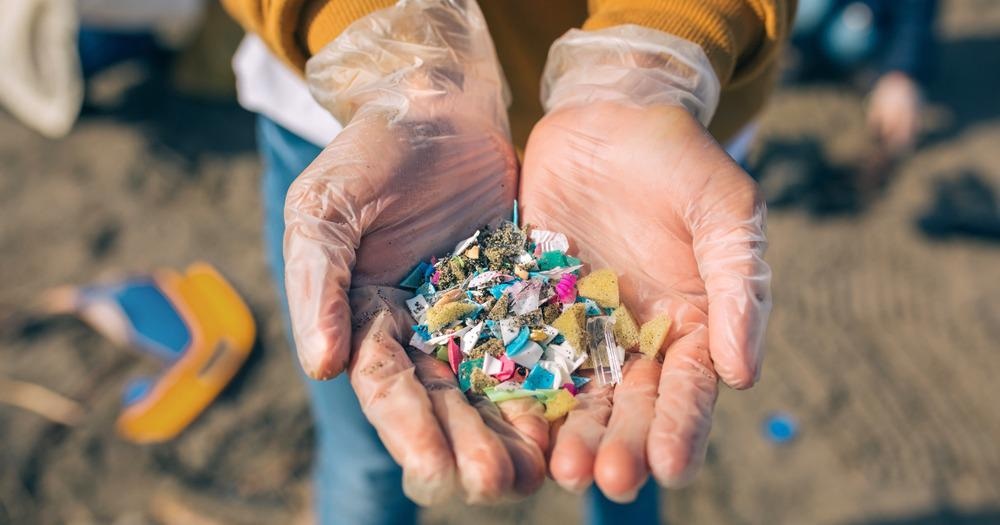New research unveils a novel nanotechnology approach to tackling microplastic pollution in water. Scientists have created a nanocoating system that could lead to microplastics that degrade when they come into contact with visible light.

Image Credit: David Pereiras/Shutterstock.com
Microplastic Pollution
Microplastic pollution has been well-documented in recent years and has caught the public’s attention. Microplastic particles are smaller than 5 mm and can seep through filtration and treatment facilities and end up in the natural environment.
These tiny, almost indestructible beads of plastic go wherever water goes, including on the ocean floor, inside fish and other sea life, and even into human and non-human land animals’ drinking water.
Scientists have recognized the urgent need for a solution to the microplastics problem. Now, companies and consumers are more aware of the risk of microplastics in new items (although they are far from being eradicated). However, existing plastic will continue to break apart without degrading, and the flow of microplastic particles in our water will continue for decades at least.
Using Light to Remove Microplastics from Water
Researchers proposed a new visible-light tool for removing microplastics from water. Photons could activate green photocatalytic removal of microplastics from waterways that would otherwise carry the polluting particles into inland water and ocean environments.
The scientists proposed a new, novel strategy for eliminating microplastics from water. Low-density microplastic particles such as polypropylene (PP) can be trapped in glass fiber substrates. These substrate materials in turn provide structural support for the photocatalytic material to coat the microplastic particle.
The study demonstrated how PP microplastics in spherical particles suspended in water can degrade through exposure to light in a process referred to as photocatalytic degradation.
Zinc oxide nanorods (ZnO NRs) are applied to the glass fibers substrates which wrap around the microplastic particles. This nanocoating enables visible light irradiation to break polymers down and degrade the microplastic particle.
When the nanocoating was applied, researchers discovered that the average volume of microplastic particles in the water had decreased by 65%. Further, GC/MS analysis of the molecules in the water that were byproducts of photodegradation showed that these are mostly nontoxic.
Nanotechnology Tackling the Microplastic Problem
From the early 1950s, plastic has found applications in almost every economic sector, eventually featuring as a staple in modern life. Since then, production has grown by around 8.7% each year, to the point where plastic is now a €600 billion global industry.
The staggering quantity of plastic that has been produced in the last 70 years is largely made up of non-degradable material. Some plastic materials could take thousands of years to degrade in nature, often steadily releasing toxic molecules into the environment in the process.
Sunlight and water waves break down this plastic material into smaller parts, but not to the level of molecular degradation. Eventually, plastic breaks up into small particles ranging from under 1 µm (on the nanoscale) to 5 mm in size. These particles are referred to as microplastics.
Microplastics pose significant and wide-ranging risks to Earth and its inhabitants. Waste particles have been found in soil, water bodies, seas, and even in bottled water for human consumption.
They also make their way into the food chain. Non-human animals have been found with plastic inside their digestive systems, and even food intended for human consumption has been found to contain microplastics. When inside digestive systems, microplastic particles have been known to translocate to other organs, resulting in localized immune system responses, sickness, and death.
Conclusion
Microplastic pollution is a large problem that needs to be tackled effectively as part of wider ambitions to reduce and remove the harm that humans have caused to the environment and ecosystems within it.
By creatively proposing a novel approach, this latest study may hold the key to unlocking this worldwide pollution problem.
References and Further Reading
Uheida, Abdusalam (2021) Visible Light Photocatalytic Degradation of Polypropylene Microplastics in a Continuous Water Flow System. Journal of Hazardous Materials. [Online] https://doi.org/10.1016/j.jhazmat.2020.124299.
Disclaimer: The views expressed here are those of the author expressed in their private capacity and do not necessarily represent the views of AZoM.com Limited T/A AZoNetwork the owner and operator of this website. This disclaimer forms part of the Terms and conditions of use of this website.